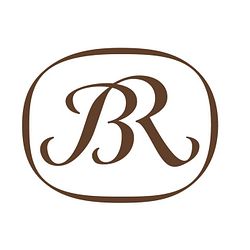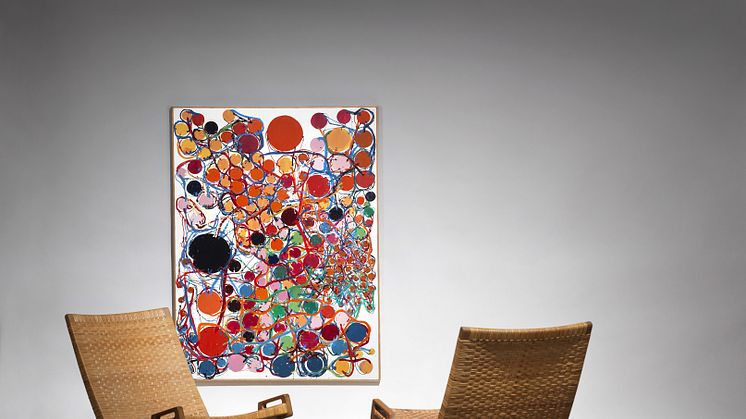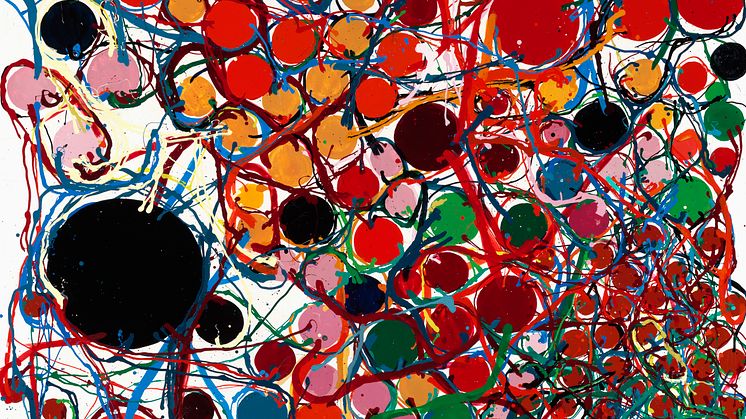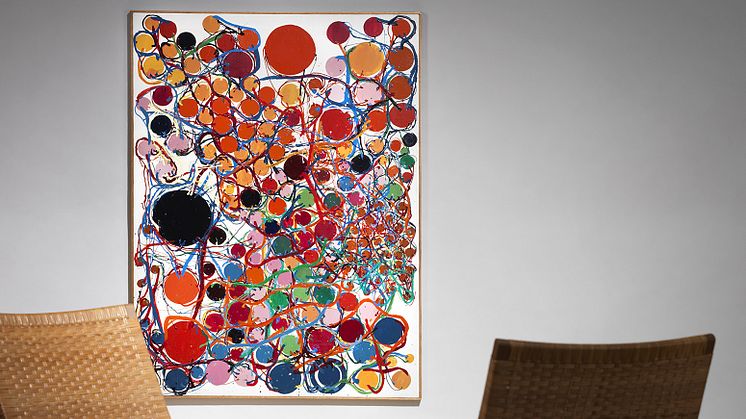
Press release -
Japanese Avant-garde Art for Millions
A valuable work of art by the Japanese avant-garde artist Atsuko Tanaka is set to go under the hammer at the Danish auction house Bruun Rasmussen on 7 March with an estimate of DKK 4–6 million. The work was purchased in the 1960s at the Minami Gallery in Tokyo by a Danish couple and has remained in the ownership of the same family ever since.
On Tuesday 7 March, you can experience Japanese avant-garde art from the 1960s, when Bruun Rasmussen Auctioneers swings the hammer over a lacquer painting by female artist Atsuko Tanaka on the podium at the auction house in Copenhagen. The estimate is DKK 4–6 million.
The work up for auction is an abstract composition made up of coloured circles and myriads of connecting lines that allow us as beholders to explore and form our own experiences in the work.
60 Years in the Ownership of One Family
The painting has, up to this point, been owned by the now 104-year-old Danish Borghild Blitz-Alstrup and her late husband Knud, who both worked in the textile industry and, among other things, ran a business in 1960’s Tokyo. It was here that they purchased the work up for auction at a local gallery. Borghild named it the “Balloon Picture”, and it has now been a fixture in the family home for 60 years.
“The painting has meant a lot to Borghild. She has often referred to it in various contexts and told the story of how her husband Knud didn’t think they should buy it and bought another one instead. Borghild subsequently purchased the “Balloon Picture”, as she named it, herself. Mainly because she liked it – she has always loved a colourful lifestyle – but also because she thought that this was perhaps an artist we were going to be hearing more about,” says Borghild’s friend, who also clearly remembers Borghild’s joy at learning, several years later, that there was an exhibition at Louisiana featuring the Japanese artist YayoiKusama. Borghild’s hunch about the future focus on female Japanese artists turned out to be right.
“But there was no question of her selling it. It was only about a year ago that Borghild said that it should now be sold. Borghild has no expectations with regard to the sale, but she is very excited,” says her friend.
Highly Sought After
According to Kathrine Eriksen, valuation specialist in modern art at Bruun Rasmussen, works by Atsuko Tanaka are highly sought after on the international art market:
“This is the first time we’ve had the pleasure of being able to offer a work by the renowned Japanese artist Atsuko Tanaka. While Tanaka’s peer Yayoi Kusama is probably better known in this part of the world thanks to the major exhibition at Louisiana, the artists shared an upbringing in wartime Japan, where they each developed their own, deeply individualised language. Kusama spent her formative years in the US under the influence of artists such as Andy Warhol. Tanaka remained in Japan, joining like-minded artists in the Gutai movement – an artistic collective based in Osaka. Tanaka later created a visual language all of her own, based on circles and lines, primarily executed in bright colours such as red, yellow, blue, green, black – and shades thereof – of which the painting here is an excellent example,” explains Kathrine Eriksen.
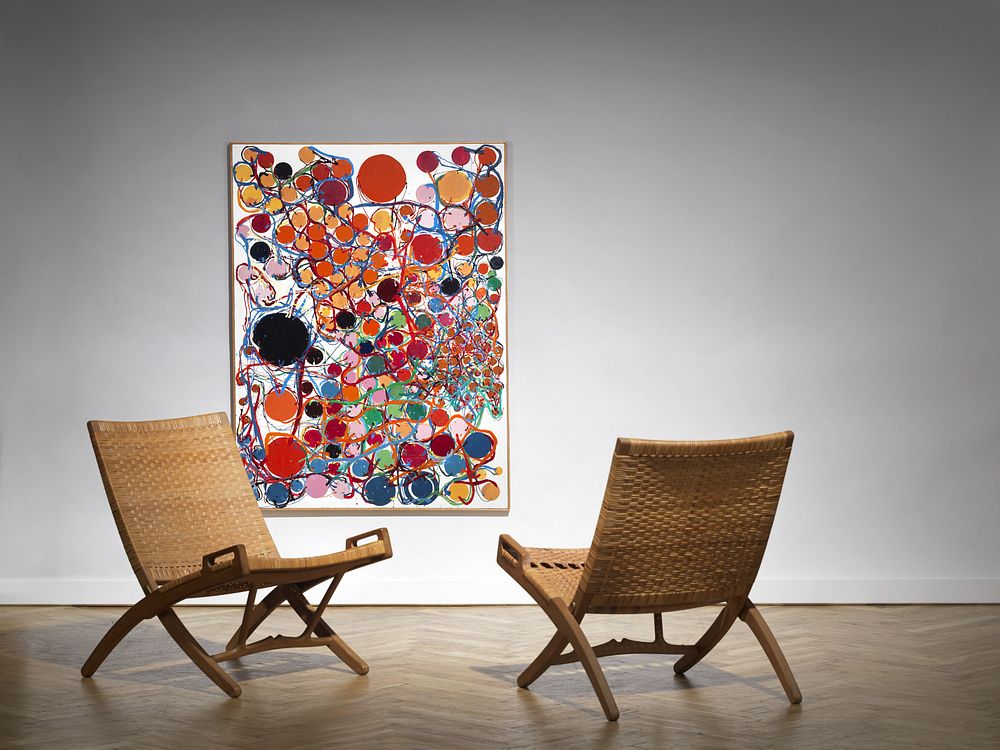
Works by Atsuko Tanaka can today be experienced in several international collections, including at MoMA in New York, and have featured in major exhibitions such as “Women in Abstraction” at the Centre Pompidou and Guggenheim Bilbao in 2021.
Atsuko Tanaka: The Dress of Flashing Light Bulbs
Atsuko Tanaka (1932–2005) was a member of Gutai, the Japanese avant-garde artist collective which experimented with new forms of art throughout the 1950s. Through, among other things, performance, installations, theatre and interactive happenings, they explored the relationship between spirit, body and material in the desire to break down the boundaries between art and life in post-war Japan.
In 1956, Tanaka appeared wearing the legendary “Electric Dress”, which is her best-known work of art. It is a sculptural “dress”, composed of two hundred flashing light bulbs and tubes covered in red, blue, yellow and green enamel paint. Tanaka herself was at the centre of this not entirely risk-free performance, about which she herself said: “I had the fleeting thought: Is this how a death-row inmate would feel?” Tanaka combined the traditional Japanese kimono with modern-day neon advertisements and the latest technology, while at the same time in many ways anticipating the feminist strategies of the 1960s and 70s, where the focus is on the actively sensing, moving and creating female body.
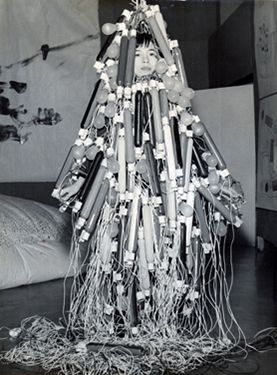
Atsuko Tanaka wearing her work Electrical Dress suspended from the temporary beam at the 2nd Gutai Art Exhibition, Ohara Kaikan hall, Tokyo, 1956. © Kanayama Akira and Tanaka Atsuko Association.
Tanaka’s Holistic Circles
In her post-Gutai period from the 1960s onwards, Tanaka developed her very own visual language based on a network of concentric circles surrounded by connecting lines, a form of technical drawing or diagram executed in bright colours such as red, yellow, blue, green, black – and shades thereof. She thus transfers “Electrical Dress” to the two-dimensionality of the canvas. Often in large formats, where, like Jackson Pollock, Tanaka applies the paint horizontally by moving around the field of the image, intertwining performative strategies and gesticulations with pictorial ones in her artistic practice.
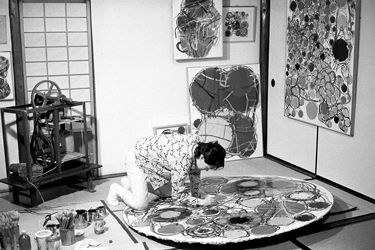
Atsuko Tanaka painting Spring 1966 (1966, now in the collection of Ashiya City Museum of Art and History) at her house, Myohoji temple, 1966. © Kanayama Akira and Tanaka Atsuko Association.
Tanaka’s use of colourful circles and lines takes on a spiritual dimension, transporting the beholder from an everyday reality into a more personal and aesthetic world. The eye is guided around the painting, but as a beholder you choose your own path: Do you venture along the bright blue paths that gracefully wind their way through the motif? Do you allow yourself to be sucked in and disappear into the big, black void that dominates the left side? Or are you attracted by the shiny red circles that manifest themselves in the physical world as afterimages on the retina, and let your gaze dance around the canvas?
Tanaka’s deep rooted, holistic philosophical perspective on the universe, nature, life and art allowed her to permeate her work with undeniable power, asserting herself as a pioneer of post-war art.
The work up for auction by Atsuko Tanaka will go under the hammer at Bruun Rasmussen’s Auction of Modern Art on Tuesday 7 March in Copenhagen.
For usage of photos of Atsuko Tanaka, please reach out.
Topics
Categories
"Going once, going twice. Sold to the lady in the front row”. For 75 years, Bruun Rasmussen Auctioneers has sold art, antiques, design, jewellery, wristwatches and collector’s items in the heart of Copenhagen. It was Arne Bruun Rasmussen who founded the auction house at Bredgade 33 in 1948, and until 2022 the Bruun Rasmussen family owned the company. Today, the company is owned by the British auction house Bonhams - one of the world's leading and oldest auction houses.
Being a part of Bonhams, means that Bruun Rasmussen has joined a global network, which benefits both the art and the customers, the latter has gained access to far more auctions and the former has a better chance of achieving the market's best hammer prices. The goal is to constantly confirm to our customers that Bruun Rasmussen is a sought-after auction house with the highest expertise in valuation and sales. Bonhams and Bruun Rasmussen share the core values of knowledge, credibility, commitment and renewal, and the old Copenhagen auction house will thus continue to base its business on its well-known values under the auspices of Bonhams.
With CEO Jakob Dupont at the helm, an extensive digitization process has taken place during the past years, making the auction house a significant player on the international market. With solid experience and in-depth knowledge complemented by highly professional advice and appraisal service, the company is the link between sellers and interested buyers from all over the world. Every year, 70,000 unique works of art are sold at three types of auctions – the traditional Live Auctions and the two web-based auctions Online Auction and Direct Auction.

